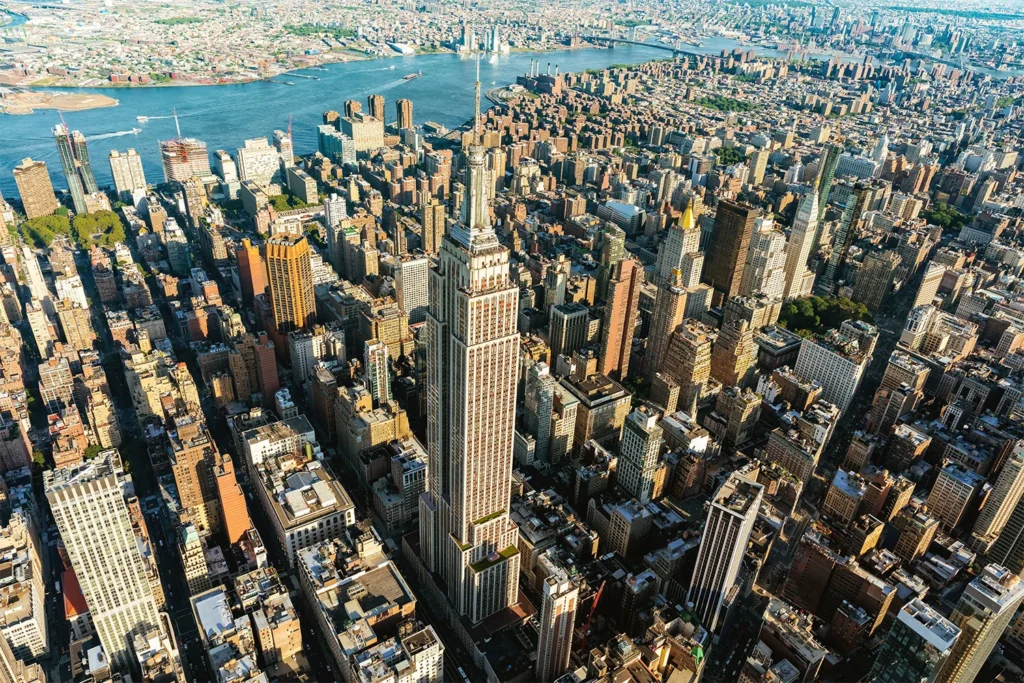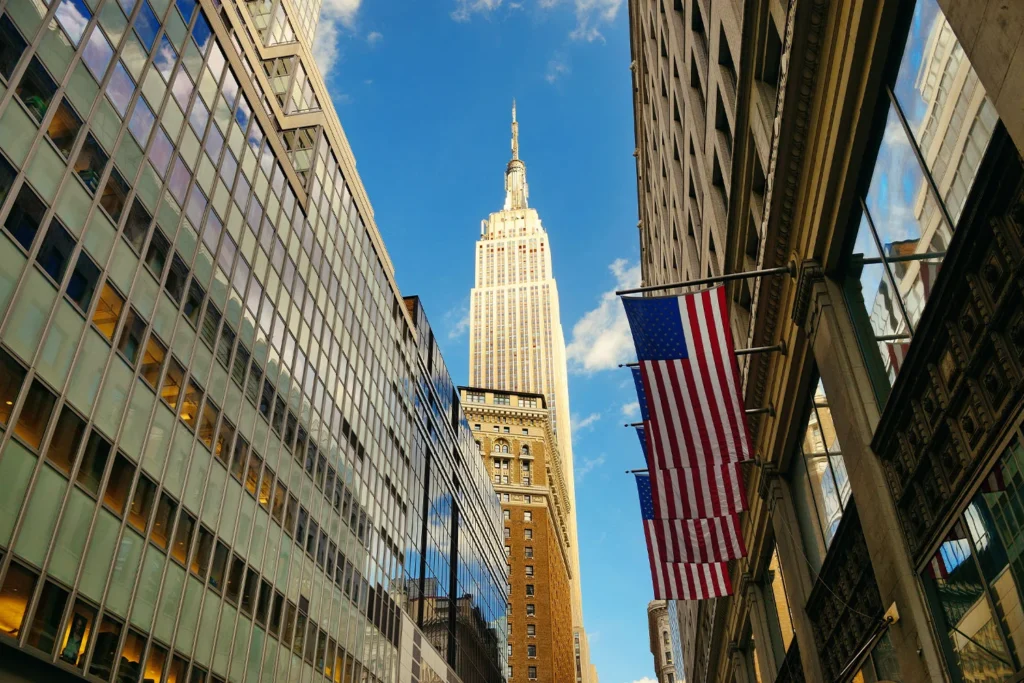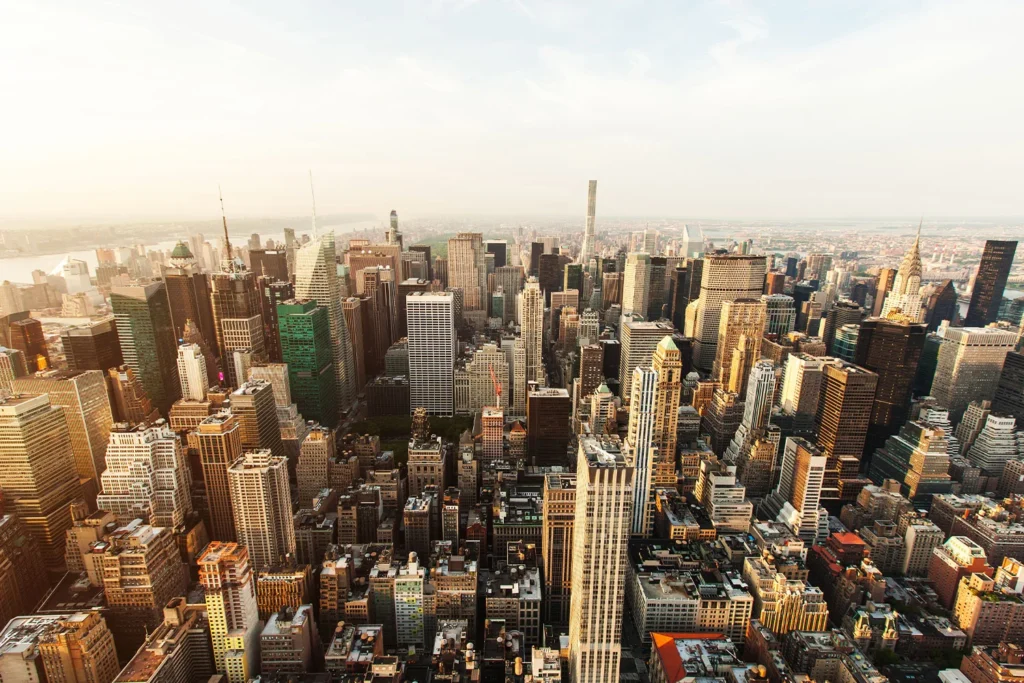If New York’s Manhattan were a theatrical stage, the Empire State Building would likely be its leading actor, drawing the attention of every spectator. Such magnetism means no one needs much convincing to visit the inside of this iconic skyscraper during a trip to New York City.
Standing at the corner of the famous Fifth Avenue and West 34th Street, the Empire State Building is an undeniable symbol of New York. This is evidenced by the nearly 4 million tourists who enter its doors each year. Most come with the dream of seeing the stunning panorama of the Big Apple, but there is so much more awaiting them inside the Empire State Building.
On a clear day, you can see as far as six states from the observation deck, and the journey to the top is enriched with stories of the building’s architectural uniqueness and its cultural and historical significance. It’s time to discover why a building that is neither the newest, tallest, nor most innovative, remains a beloved favorite for both tourists and New Yorkers alike.
FUN FACT: Ever wondered where the name Empire State Building comes from? “Empire State” is actually a nickname for the state of New York. While the origins of this nickname aren’t entirely clear, one theory ties it to an extraordinary letter. In 1785, George Washington expressed his admiration for New York, referring to it as “the Seat of the Empire.”
Record-Breaking Construction Time
Back in early 1928, the spot where the skyscraper now stands was occupied by the Waldorf-Astoria Hotel. But these were the hotel’s final days, as that year, the location was sold to Bethlehem Engineering Corporation. They had a bold vision: to demolish the hotel and create the world’s most ambitious building project. And they didn’t waste any time—construction of the world’s first 100-story skyscraper officially began on March 17, 1930, St. Patrick’s Day.

At the time of its construction, New York was in the midst of an intense competition for the title of world’s tallest building. This so-called “race to the skies” included contenders like 40 Wall Street and the Chrysler Building, both of which were already under construction when work on the Empire State Building began. Despite this rivalry, nothing slowed down the project’s momentum. The building’s skeleton was rising at an astounding rate of 4.5 stories per week, and that pace never faltered. In the end, the Empire State Building was completed in the record time of 1 year and 45 days. On May 1, 1931, President Herbert Hoover ceremoniously pressed a button to illuminate the skyscraper for the first time, lighting up the New York skyline with thousands of lights.
The Highs and Lows of Empire State Building History
One of the darkest moments in the building’s history occurred on July 28, 1945, when a U.S. Army B-25 bomber crashed into the 79th floor of the north side of the Empire State Building. One of the plane’s engines tore through the building and landed on the opposite side of the street. Imagine the immense force behind that collision! Following this disaster, it became illegal for airplanes to fly below 800 meters over New York City. Tragically, 14 people lost their lives in the accident, and the damage was estimated at nearly $1 million. Yet, remarkably, the building reopened just two days after the crash.
Thankfully, this remains the only tragic episode in the building’s storied past. As the tallest building in the world at the time, the Empire State Building quickly gained fame as a tourist attraction. Just 15 years after its opening, it was home to several large organizations, employing about 15,000 people. By 1980, nearly 2 million visitors were making their way to its observation decks every year. Over the decades, ownership of the building changed hands several times, but the love and fascination it inspires in both Americans and international tourists have remained constant.
Even with many new, impressive buildings joining the New York City skyline over the years, the Empire State Building has retained its place as a beloved architectural landmark. In a 2007 poll by the American Institute of Architects, it was ranked as America’s favorite architectural piece, a status that remains unchanged. According to TripAdvisor, the Empire State Building was the #1 attraction in the United States in both 2022 and 2023.
FUN FACT: According to the original plans, the spire of the Empire State Building was intended to serve as a terminal for airships. In this scenario, the 86th floor would have been a waiting room for passengers, who, after taking an elevator to the 101st floor and climbing a few rungs of a ladder, would board airships tethered to the top of the building. Fortunately, it was quickly realized how dangerous such a method of boarding would be, and the idea was abandoned.
A Jewel of American Architecture
A star of the New York City skyline, the Empire State Building is a local Art Deco icon. Its distinctive tapered shape defines the panorama of New York. The entire building has a symmetrical form, with its facade entirely clad in stone slabs made of special gray limestone. The building’s shape isn’t accidental—thanks to its setbacks, sunlight can still reach the streets surrounding the towering skyscraper. Most decorative elements are geometric, though one exception is the ornate design of the main entrance, which opens onto Fifth Avenue. This portal consists of three sets of metal doors and is flanked by two columns topped with stone eagles.
Empire State Building by the Numbers
Even if you haven’t yet had a personal encounter with this majestic structure, there are a few numbers that will help you better imagine it. The building has one underground floor, beneath which lie the foundations—reaching nearly 17 meters into the ground. However, to truly appreciate it, you must look up rather than down. The Empire State Building’s total height, including its characteristic spire, is 443 meters, while its structural height is 381 meters, making it the fourth tallest building in New York. To reach the 102nd floor, where the famous observation deck is located, you would have to climb 1,860 steps from street level. Fortunately, no one has to walk up, as the Empire State Building is equipped with 73 elevators.

The entire structure weighs over 360,000 tons. When you realize that the outer walls used 740 tons of stainless steel and more than 10 million bricks, and the electrical wiring stretches nearly 692 km, that figure starts to make sense. The building boasts 6,500 windows, and behind them lies 200,500 square meters of office space. No wonder the Empire State Building even has its own zip code! Lastly, an interesting note for photography enthusiasts: the spire of the skyscraper is struck by lightning an average of 25 times a year, so if you’re visiting New York during a storm, get your cameras ready—such a shot makes for an impressive capture.
FUN FACT: This architectural symbol of New York held the title of the world’s tallest building for nearly 40 years after its completion. It lost that title in 1972 with the completion of the North Tower of the World Trade Center. After the tragic events of September 11, 2001, the Empire State Building once again became the tallest building in New York for another 10 years, but it has never again been the tallest building in the U.S. or the world.
Race to the Top
None of the building’s 73 elevators are of any use to participants in the Empire State Building Run-Up, a footrace from the ground floor to the 86th floor of the skyscraper. The race, covering a vertical distance of 320 meters, has been held annually since 1978. It is one of the most famous tower races in the world, attracting hundreds of enthusiasts each year. The most memorable participant was Australian cyclist Paul Crake, who set a record in 2003, completing the climb in just 9 minutes and 33 seconds.
Empire State Building Lights
From the very beginning of the building’s existence, floodlights were installed at its top, but it wasn’t until 1976 that the lights of the Empire State Building became an integral part of the New York skyline. The skyscraper is typically illuminated in classic white, but the Empire State Building can light up in a vibrant array of colors to highlight holidays, significant events, or anniversaries.

The Empire State Building turns into a rainbow on days dedicated to the LGBT community, adopts the colors of the American flag on Independence Day, and after the passing of retired basketball player Kobe Bryant in January 2020, the building was illuminated in purple and gold, the colors of his former team, the Los Angeles Lakers. The lights are turned off only on foggy autumn nights for the safety of migrating birds.
More Than Just Colors
The building is now equipped with LED lighting, capable of projecting up to 16 million colors. As a result, the computer-controlled system can display not only colors but also full images. In 2016, after the election of the new U.S. President, the facade featured a likeness of Donald Trump. The building has also been used as a scoreboard during the 2012 elections. It frequently hosts light shows synchronized to music. Interestingly, special lighting requests can come not only from organizations but also from private individuals—making it an unusual way to propose or send birthday wishes.
Star of Architecture and Its Remarkable Guests
The Empire State Building welcomes countless celebrities, members of royal families, world-renowned athletes, and artists to its hallways and observation decks each year. So, if you visit, keep your eyes peeled—you never know if Oprah Winfrey, Alicia Keys, or Tom Holland might be walking right behind you.
But the Empire State Building doesn’t just host stars—it’s a star in its own right. This cultural icon has appeared in countless films, TV shows, and works of art. Among the most famous are Independence Day, The Amazing Spider-Man, and Sleepless in Seattle. Of course, no list would be complete without mentioning the beloved, giant gorilla—yes, it was atop the Empire State Building that the mighty King Kong famously clung in the legendary movie.
What to See Inside the Empire State Building?
The main attraction for most tourists visiting the Empire State Building is its highest floor. It’s no surprise, as it’s one of the most Instagrammable spots, offering a magical perspective of New York City through its glass walls.

However, this is not the only observation deck inside the skyscraper. You can also enjoy a breathtaking view of the city that never sleeps from the 86th floor, which features both an enclosed gallery and an open-air terrace. Another option is the 80th floor, where you can compare the authentic view of the city with an extraordinary mural drawn by British artist Stephen Wiltshire. When visiting this cultural icon, be sure to set aside enough time, as the observation decks are just a fraction of what you can explore in the architectural heart of Midtown Manhattan.
FUN FACT: The mural on the 80th floor was created in an unusual way. Reportedly, the artist took a 45-minute helicopter ride over Manhattan, and then, once inside the Empire State Building, drew a highly detailed depiction of the cityscape entirely from memory.
The Lobby – More Than a Hallway
Every guide, blog, and New York City enthusiast will tell you to pause for a moment in the famous lobby—the entrance hall of the Empire State Building. To understand why this room draws such fascination, just look up. It’s the sprawling mural stretching across the ceiling that makes this corridor the most dazzling element of the building’s design.
The mural depicts a starry sky in the classic Art Deco style, adorned with 23-karat gold stars, solar flares, and gears that gleam under the lights. It’s an image that greeted visitors for decades, although with some interruptions. In the 1960s, it was covered up by a drop ceiling. Perhaps the owner was trying to follow modern trends, but fortunately, in 2007, artists and historians began restoring the mural to its original glory. The restoration took two years (longer than the construction of the entire Empire State Building), but it was worth it, as today, the ceiling dazzles visitors just as it did when the skyscraper first opened.
Exhibitions and Artifacts
Most of the usable space in the Empire State Building is dedicated to commercial and office areas. However, not all of it is. Few people know that the building also houses exhibits and fascinating artifacts that reveal the history and secrets of this iconic skyscraper. Visitors are transported back in time, experiencing scenes from the Waldorf-Astoria Hotel that once stood here, encountering representations of the workers who built the structure, and hearing announcements about the opening of the skyscraper. An impressive exhibit also explains the building’s lighting system and features a collection of photos of its most famous visitors.
Among the exhibits, you can also find a replica of the original Otis elevator car and an extraordinary montage of over 600 clips from commercials, films, TV shows, comics, and games that have featured the iconic building. And if your favorite appearance of the Empire State Building is its role in the movie King Kong, you’ll be delighted by the area dedicated to the giant ape. You can touch the enormous monkey hands that smashed through the walls and feel a thrill, as though you’re meeting Kong himself.
Tips – What You Should Know Before Your Visit
Once you’ve decided on which day of your trip to New York will be dedicated to exploring the Empire State Building, it’s best to buy your tickets online in advance. This will allow you to skip the long lines at the ticket counters. Unfortunately, there is still some waiting involved for entry, but if time is more valuable to you than money, you can skip this as well by purchasing an Express Pass, which grants immediate access.
Before purchasing your tickets, consider which option suits you best. All tickets include access to the exhibits and the 86th-floor observation deck. However, to visit the highest level, the 102nd floor, you’ll need to pay an additional fee. Other more exclusive ticket options allow you to see the New York sunrise from the building, take a guided tour with an authorized expert who can customize the tour to your interests (Premium Experience), or even plan two visits in one day (AM/PM package).
GOOD TO KNOW: If your primary goal during your trip to New York is to visit the city’s main attractions, consider purchasing the New York City Pass. This special pass can save you money on admission to iconic spots like the Empire State Building and the American Museum of Natural History.
Practical information
- It is best to purchase tickets for the Empire State Building in advance. This way, you can avoid standing in long lines and reduce the risk of tickets being sold out.
- Address: 20 W 34th St., New York, NY 10001, United States
- Buy tickets on GetYourGuide